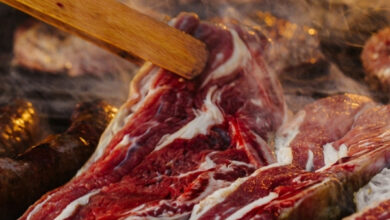
Lamb vs. Beef: Which Is Healthier?
Nutritional Breakdown: Lamb vs. Beef
Both lamb and beef are rich in protein, vitamins, and minerals. However, they differ in the amount of fat, calories, and other important nutrients. Here’s a closer look at the nutritional content of each meat.
Protein Content
Lamb: A 3-ounce serving of lamb provides around 23 grams of protein. This makes it an excellent source of protein, which is essential for muscle building, tissue repair, and overall body function.
Beef: A 3-ounce serving of beef contains approximately 22 grams of protein. Like lamb, beef is also a high-quality source of protein, providing the necessary building blocks for a healthy body.
Fat Content
Lamb: Lamb is known for having a higher fat content, especially saturated fat. A 3-ounce serving of lamb can contain about 9 grams of fat, with 4 grams of that being saturated fat. This higher fat content can contribute to a higher calorie intake.
Beef: The fat content in beef varies depending on the cut. Leaner cuts of beef, like sirloin or tenderloin, typically contain around 6-7 grams of fat per 3-ounce serving, with 3 grams of saturated fat. Higher-fat cuts, such as ribeye, can contain significantly more fat.
Vitamins and Minerals
Lamb: Lamb is a good source of essential nutrients such as vitamin B12, zinc, iron, and niacin. These vitamins and minerals play a crucial role in maintaining energy levels, supporting the immune system, and promoting overall well-being.
Beef: Beef is also rich in vitamin B12, iron, and zinc, which are vital for red blood cell production, energy metabolism, and immune function. Beef is particularly known for its high bioavailability of heme iron, the form of iron that is most easily absorbed by the body.
Health Benefits of Lamb
Lamb can offer several health benefits, especially when it comes to heart health. One of the standout benefits of lamb is its higher omega-3 fatty acid content, particularly in grass-fed lamb. Omega-3s are known for their anti-inflammatory properties and support of brain health, reducing the risk of heart disease.
Additionally, lamb contains conjugated linoleic acid (CLA), a type of fatty acid that has been linked to several potential health benefits, including fat loss, improved muscle mass, and even anti-cancer properties. However, the higher fat content in lamb means it should be consumed in moderation, particularly if you are watching your calorie intake.
Health Benefits of Beef
Beef, particularly lean cuts, is an excellent source of high-quality protein and essential nutrients. Lean beef is a great option for those looking to build and repair muscles, as protein is vital for these processes. It’s also rich in iron, a mineral essential for producing red blood cells and preventing anemia.
Beef is also a valuable source of zinc, which is important for immune function, wound healing, and cellular growth. Additionally, beef’s high bioavailability of iron makes it an ideal option for individuals who need to increase their iron intake, especially those with iron deficiencies.
Potential Drawbacks of Lamb
While lamb offers several health benefits, it also has a few potential drawbacks. The higher fat content in lamb can be a concern, particularly for those looking to reduce their intake of saturated fat. Consuming too much saturated fat over time can lead to high cholesterol and increase the risk of heart disease.
Additionally, some people may find lamb harder to digest due to its higher fat content. For those with sensitive digestive systems, lamb may not be the most ideal choice.
Potential Drawbacks of Beef
Beef, especially fatty cuts, can also present certain health risks. Consuming high-fat beef regularly may contribute to higher cholesterol levels, which can increase the risk of cardiovascular diseases. Furthermore, processed beef products like sausages, burgers, and deli meats can contain unhealthy additives such as sodium, nitrates, and preservatives.
Overconsumption of red meat, including beef, has been linked to an increased risk of certain health issues such as heart disease, cancer, and type 2 diabetes. Moderation is essential when incorporating beef into your diet.
Which Is the Healthier Option: Lamb or Beef?
Both lamb and beef offer valuable nutrients, but the healthier choice depends on your specific health goals and dietary preferences.
- For leaner protein: Lean cuts of beef, such as sirloin or tenderloin, tend to have less fat and fewer calories than lamb. These cuts are ideal for those looking to maintain a leaner body or reduce their saturated fat intake.
- For omega-3s and CLA: If you are looking to increase your intake of omega-3 fatty acids and conjugated linoleic acid, lamb—especially grass-fed lamb—can be a great option.
- For iron and zinc: Both lamb and beef are excellent sources of iron and zinc, but beef’s high bioavailability of heme iron makes it particularly valuable for those struggling with iron deficiency.
The key is to choose lean cuts of either meat, limit your intake of fatty cuts, and consume red meat in moderation to ensure a healthy diet.
Conclusion

Both lamb and beef provide essential nutrients and offer numerous health benefits, but they come with certain drawbacks, especially when it comes to fat content. If you’re aiming for a leaner protein source, beef may be the better option, particularly lean cuts. However, lamb’s higher omega-3 content and CLA may make it a worthwhile addition to your diet if consumed in moderation. Ultimately, both meats can be part of a healthy, balanced diet when chosen wisely and eaten in moderation.





